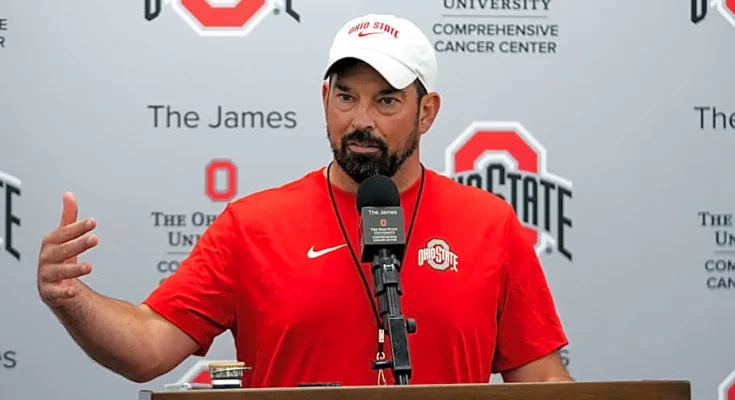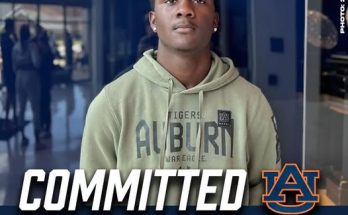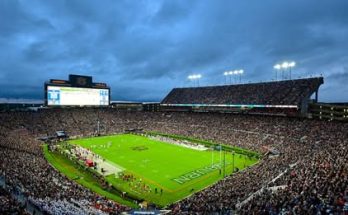Ohio State has always carried with it the immense weight of expectations, and that is no different heading into another season under Ryan Day. With a roster filled with blue-chip talent, one of the most closely followed storylines every year revolves around who will line up under center and guide the Buckeyes’ offense. The quarterback position at Ohio State is more than just a role in the lineup—it is a legacy, a position tied to the program’s national championship hopes and the constant pressure of representing one of college football’s biggest brands. This offseason, with the transfer portal continuing to reshape the college football landscape, many wondered if Ohio State would make a splash by bringing in another experienced arm to solidify its depth and perhaps add competition to the room. But Ryan Day made it clear that his decision was deliberate. He didn’t pursue a transfer quarterback, not because he didn’t have the opportunity, but because he wanted to invest in the players already on his roster.
Day explained that his choice reflected a long-term vision for the program rather than a short-term fix. He has three young passers on the roster, each with unique strengths, and he believes in their potential to develop into capable leaders. The modern transfer portal era has made it almost second nature for programs to supplement weaknesses with outside additions, especially at quarterback where one proven veteran can stabilize a season. Ohio State, however, is in a different situation. The Buckeyes don’t just want a one-year plug-and-play solution—they want to build continuity and develop quarterbacks who understand the system from the ground up. That philosophy has worked before, with names like C.J. Stroud and Justin Fields flourishing under Day’s guidance. Day is betting that it will work again, even in a climate where patience is often in short supply.
The three quarterbacks on the roster represent different stages of development, and the challenge for Day and his staff is finding a balance between competition, growth, and trust. The names at the center of the conversation include players who have shown flashes of talent but are still waiting for that defining moment. In a program like Ohio State, where fans expect Big Ten titles and College Football Playoff appearances, the margin for error is thin. That is why some outsiders questioned the decision not to bring in a transfer—what if the development curve is steeper than anticipated? Day’s confidence in his quarterbacks speaks to both his evaluation of their talent and his belief in the program’s system.
The decision also signals a cultural stance. In the transfer era, many players expect instant opportunities, and many coaches are quick to look outside the roster when questions arise. By standing firm with his three quarterbacks, Day is sending a message to his team about loyalty and development. He is telling his players that if you commit to Ohio State, the staff will commit to you. This is not just about roster management—it is about culture building. When quarterbacks see that the program is willing to invest in them rather than shop for a quick replacement, it fosters trust. That trust is vital in a position that requires leadership, composure, and buy-in from the entire locker room.
Day has also been clear that developing quarterbacks is part of his personal identity as a coach. Before becoming head coach at Ohio State, he built his reputation as one of the brightest offensive minds in football, particularly in developing quarterbacks. His track record speaks for itself, with players not only succeeding in college but transitioning to the NFL. By choosing to stick with his three passers, Day is essentially betting on himself as much as on them. He believes his system, his coaching staff, and his culture can mold them into championship-caliber players.
Still, there are risks. The transfer portal is filled with experienced quarterbacks, some of whom have started in major conferences and could have provided immediate stability. Injuries are another factor—quarterback depth is always fragile, and one setback could leave the team exposed. In a season where Ohio State is once again expected to contend for a playoff spot, any stumble at quarterback could derail those aspirations. But Day appears comfortable with that risk, suggesting that he values the potential long-term rewards of developing his players over the immediate security of a transfer.
Recruiting plays a major role in this decision as well. Ohio State consistently attracts some of the best high school quarterbacks in the nation. Bringing in a transfer could potentially discourage future recruits who worry about blocked pathways to playing time. By showing confidence in the players already in the room, Day is also signaling to recruits that if you come to Ohio State, you will get your chance to develop and play without the program constantly looking for the next quick fix. In the competitive world of recruiting, that message matters. Quarterbacks want to know they can trust the staff to stick with them.
The move also illustrates the broader debate in college football about the balance between development and immediate results. Programs like Ohio State face immense pressure to win now, every year. The transfer portal makes it easier than ever to plug holes, but it also changes the dynamic of how rosters are built. Day is resisting that temptation, staying closer to a traditional model of development, even while acknowledging the realities of modern college football. Whether that decision pays off this season will depend heavily on how quickly his three quarterbacks grow into the role.
For fans, this approach adds layers of intrigue to the upcoming season. Who among the three will seize the opportunity? Will it be a competition that stretches into the season, or will one player emerge as the clear leader early? Ohio State’s offense has always been dynamic, and with weapons at wide receiver and a strong supporting cast, the quarterback’s job is both difficult and exciting. Whoever wins the role will not lack for tools, but the pressure will be immense. Day’s decision not to bring in outside competition means it is entirely on this trio to rise to the occasion.
The long-term impact of this choice could extend beyond this season. If one of these quarterbacks blossoms into a star, it validates Day’s decision and reinforces Ohio State’s reputation as a program that can develop elite passers. If the experiment falters, however, the criticism will be swift. In the Big Ten, rivals like Michigan and Penn State continue to push forward, and a misstep at quarterback could tilt the balance of power. Day has lived with criticism before, particularly surrounding The Game against Michigan, but his confidence suggests he is willing to weather the scrutiny if it means building the right foundation.
Day’s stance also reflects the changing identity of Ohio State under his leadership. While Urban Meyer’s tenure was marked by a win-at-all-costs mentality that often leaned on veteran transfers and aggressive roster moves, Day appears to be shaping a program that values internal growth and stability. That does not mean he ignores the transfer portal altogether—Ohio State has made key portal additions at other positions—but at quarterback, he is drawing a clear line. It is a position too central, too tied to leadership and identity, to outsource for a one-year rental unless absolutely necessary.
For the players themselves, this is the chance they have been waiting for. Young quarterbacks at top programs often spend years in the shadows, watching older players carry the load while waiting for their turn. Now, with the head coach publicly stating his faith in them, they have the opportunity to prove they belong on the national stage. The pressure will be high, but so will the reward if they succeed. At Ohio State, quarterbacks are not just players—they are potential Heisman contenders, future first-round draft picks, and faces of the program. For these three, the door is wide open.
In the broader landscape of college football, Day’s decision may spark discussion about how other elite programs manage their quarterback rooms. The transfer portal is reshaping the sport in real time, and every choice carries consequences. Some programs thrive by adding experienced transfers, while others risk stagnation if their development pipeline falters. Ohio State is taking a stand that development still matters, that patience is still valuable, and that trust in your players can pay dividends. Whether that belief holds true will play out on the field in the coming months.
Ultimately, Ryan Day’s refusal to add a transfer quarterback this offseason reflects more than just a roster decision. It is a statement about identity, trust, and vision. He believes in his quarterbacks, he believes in his staff, and he believes in the culture Ohio State is building. In an era where quick fixes are often the norm, Day is choosing the harder path, one that requires patience, belief, and resilience. For Ohio State fans, it means this season will be a test not just of talent, but of philosophy. If it succeeds, it could strengthen Ohio State’s position as a quarterback factory for years to come. If it fails, the questions will be loud, and the pressure on Day will only intensify. But one thing is clear: Ryan Day is not afraid to make bold choices, and this may be one of the boldest yet.



